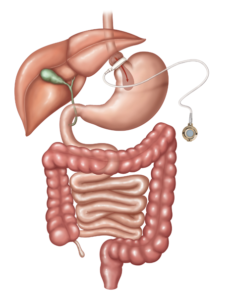LAP-BAND
Lap-Band surgery, or laparoscopic adjustable gastric band surgery, is one of the least invasive surgical options available for obesity. Adjustable gastric banding is a purely restrictive procedure that involves placing a band around the uppermost portion of the stomach.
The Lap-Band reduces your stomach’s capacity, limiting the amount of food you are able to eat at one time.
How is LAP-BAND surgery performed?
 Several small abdominal incisions are made and instruments are placed through the incisions. Your surgeon uses a laparoscope, a tool with a tiny camera, to see inside your abdomen. A soft and adjustable silicone band is then placed around the top portion of the stomach, leaving a small pouch available for food. By creating a small pouch, most patients will feel full after eating only small amounts of food. This will help you lose weight.
Several small abdominal incisions are made and instruments are placed through the incisions. Your surgeon uses a laparoscope, a tool with a tiny camera, to see inside your abdomen. A soft and adjustable silicone band is then placed around the top portion of the stomach, leaving a small pouch available for food. By creating a small pouch, most patients will feel full after eating only small amounts of food. This will help you lose weight.
The size of the stomach opening can be adjusted by filling the band with sterile saline, which is injected through a port placed under the skin. Reducing the size of the opening is done gradually over time with repeated adjustments or “fills.” As the name suggests, the procedure can be adjusted and even reversed.
Most surgeries take around an hour. Sometimes a hiatal hernia, if present, will be repaired at the same time. Most patients are able to go home same day. Certain medical conditions may require an overnight stay. Most patients are back to work in about a week. Full recovery from gastric band surgery usually occurs in about 2 weeks.
How does LAP-BAND® cause weight loss?
The Lap-Band reduces your stomach’s capacity, limiting the amount of food you are able to eat at one time. As a result, you feel full sooner and stay satisfied longer. It will take several follow-up visits to get your band adjusted with the right amount of saline. If food is going too quickly through the band, you feel hungry between meals, or you are eating more than a small plate of food to get full – you probably need a fill. You should lose a minimum of 1-2 pounds a week when properly adjusted. If you feel the band is too tight, feel like food is sticking, or have reflux symptoms-it’s too tight and you need some fluid removed. Frequent follow-up with your bariatric surgeon during the first year is important for success.
Lap-Band surgery is a tool to help you achieve sustained weight loss by limiting how much you can eat, reducing your appetite. Surgery by itself will not solve morbid obesity. The amount of weight you lose depends both on the band and your motivation and commitment to a new lifestyle such as exercising regularly and new eating habits.
Average weight loss is 40% of your excess body weight and is slower than other bariatric surgeries.
What are the risks of LAP-BAND® surgery?
There are the standard risks of general anesthesia, blood clot formation, bleeding, infection, and injury to surrounding structures. Specific complications associated with adjustable gastric banding include band erosion, band slippage, port leak/displacement, gastroesophageal reflux.
LAP-BAND® advantages:
- Least invasive surgical approach – No stomach stapling or cutting, or intestinal re-rerouting
- Adjustable – It can be tailored to your needs
- Reversible – Lowest mortality/operative complication rates
- Low malnutrition risk
LAP-BAND® disadvantages:
- Slower weight loss than other bariatric procedures
- Regular follow-up critical for optimal results
- Requires an implanted medical device – potential for band slippage, port flip or leak
Our Lap-Band patients come to us from Winston-Salem, Burlington, Greensboro, High Point, Kernersville and neighboring areas.You can find out more about your weight loss surgery options and start the process by attending a seminar.